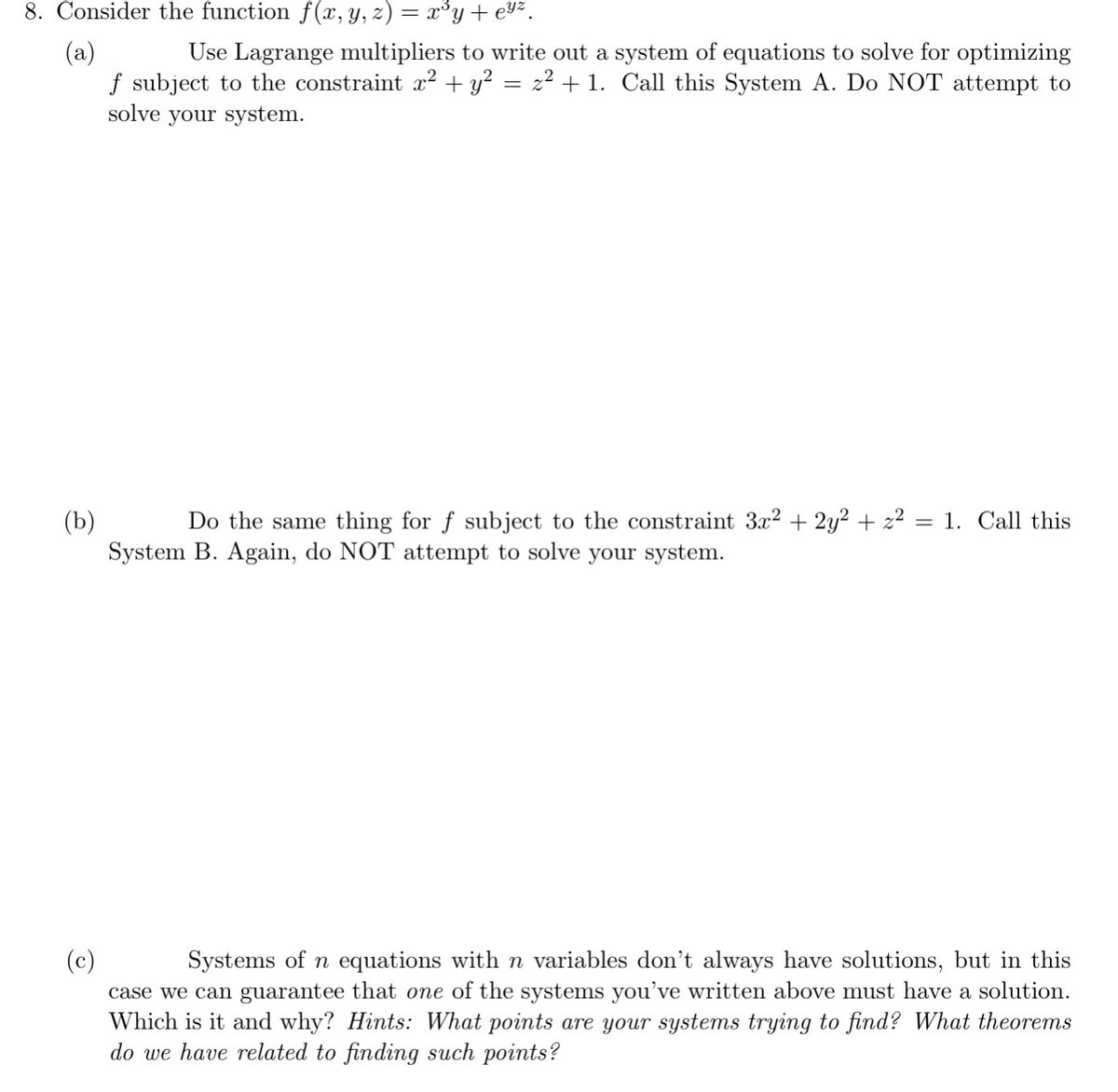8. Čonsider the function f (x, y, z) = x°y + e9². (a) f subject to the constraint x2 + y? = z² + 1. Call this System A. Do NOT attempt to solve your system. Use Lagrange multipliers to write out a system of equations to solve for optimizing Do the same thing for f subject to the constraint 3x2 + 2y² + z² = 1. Call this (b) System B. Again, do NOT attempt to solve your system. Systems of n equations with n variables don't always have solutions, but in this case we can guarantee that one of the systems you’ve written above must have a solution. Which is it and why? Hints: What points are your systems trying to find? What theorems do we have related to finding such points?
8. Čonsider the function f (x, y, z) = x°y + e9². (a) f subject to the constraint x2 + y? = z² + 1. Call this System A. Do NOT attempt to solve your system. Use Lagrange multipliers to write out a system of equations to solve for optimizing Do the same thing for f subject to the constraint 3x2 + 2y² + z² = 1. Call this (b) System B. Again, do NOT attempt to solve your system. Systems of n equations with n variables don't always have solutions, but in this case we can guarantee that one of the systems you’ve written above must have a solution. Which is it and why? Hints: What points are your systems trying to find? What theorems do we have related to finding such points?
Linear Algebra: A Modern Introduction
4th Edition
ISBN:9781285463247
Author:David Poole
Publisher:David Poole
Chapter2: Systems Of Linear Equations
Section2.4: Applications
Problem 17EQ
Related questions
Question
college level
topic: lagrange multipliers -> system of equations, vector calculus

Transcribed Image Text:8. Consider the function f(x, y, z) = x°y+ e9².
Use Lagrange multipliers to write out a system of equations to solve for optimizing
(a)
f subject to the constraint x² + y² = z² + 1. Call this System A. Do NOT attempt to
solve your system.
Do the same thing for f subject to the constraint 3x? + 2y? + z? = 1. Call this
(b)
System B. Again, do NOT attempt to solve your system.
(c)
case we can guarantee that one of the systems you've written above must have a solution.
Which is it and why? Hints: What points are your systems trying to find? What theorems
do we have related to finding such points?
Systems of n equations with n variables don't always have solutions, but in this
Expert Solution
This question has been solved!
Explore an expertly crafted, step-by-step solution for a thorough understanding of key concepts.
Step by step
Solved in 3 steps with 2 images

Recommended textbooks for you

Linear Algebra: A Modern Introduction
Algebra
ISBN:
9781285463247
Author:
David Poole
Publisher:
Cengage Learning

Algebra for College Students
Algebra
ISBN:
9781285195780
Author:
Jerome E. Kaufmann, Karen L. Schwitters
Publisher:
Cengage Learning

Elementary Linear Algebra (MindTap Course List)
Algebra
ISBN:
9781305658004
Author:
Ron Larson
Publisher:
Cengage Learning

Linear Algebra: A Modern Introduction
Algebra
ISBN:
9781285463247
Author:
David Poole
Publisher:
Cengage Learning

Algebra for College Students
Algebra
ISBN:
9781285195780
Author:
Jerome E. Kaufmann, Karen L. Schwitters
Publisher:
Cengage Learning

Elementary Linear Algebra (MindTap Course List)
Algebra
ISBN:
9781305658004
Author:
Ron Larson
Publisher:
Cengage Learning